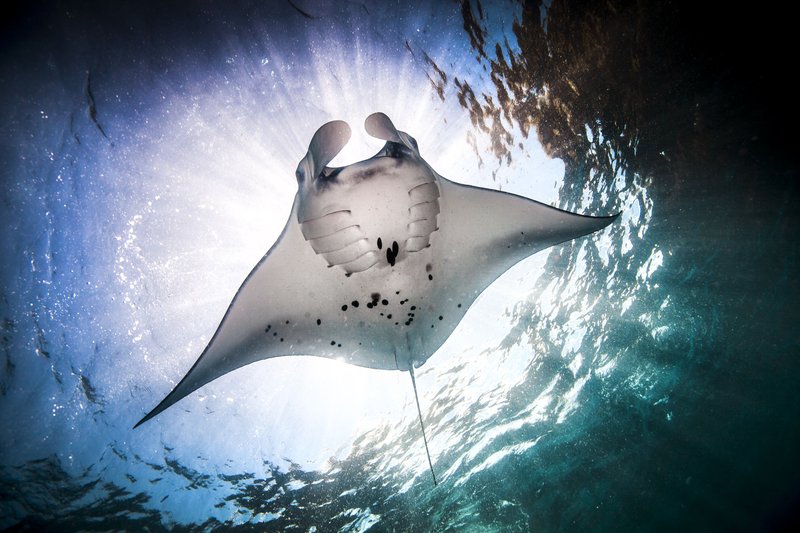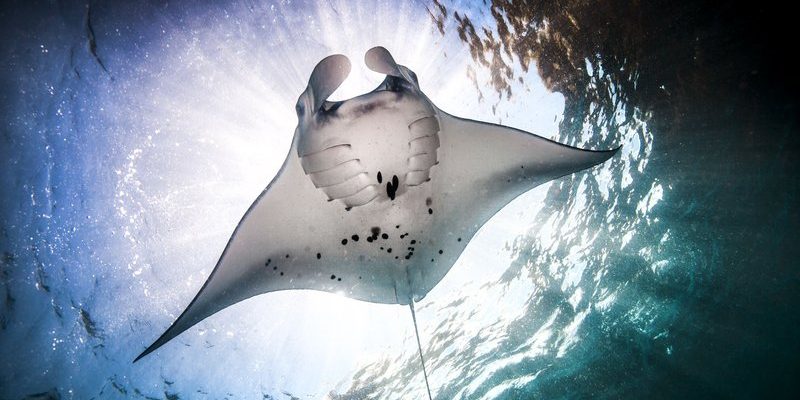
These adaptations are like superhero powers. They allow manta rays to navigate their environment, find food, and even interact with other marine life. While they might seem like gentle giants, they’ve got a whole arsenal of tricks that ensure they’re well-equipped for life beneath the waves. Let’s dive deeper into the amazing adaptations of manta rays, and see how these traits help them flourish in the ocean.
Body Structure: The Perfect Design for Swimming
One of the most striking features of manta rays is their unique body structure. Their flat, disc-shaped bodies are designed for efficient swimming. Think of them like the wings of a bird. When manta rays glide through the water, they use their pectoral fins—essentially their “wings”—to propel themselves smoothly. This design helps them minimize resistance, allowing them to move effortlessly.
Their streamlined shape is crucial for catching prey. Manta rays feed primarily on plankton, tiny organisms that float in the ocean. Their large mouths, located at the front of their bodies, can scoop up massive amounts of water filled with these microscopic snacks. When they open their mouths wide while swimming, it’s like they’re catching an ocean buffet. The water passes through their gills, where they filter out food, showcasing one of nature’s most effective feeding strategies.
Additionally, their bodies are covered with a layer of mucus. This slimy coating not only helps protect their skin from parasites and diseases but also reduces friction as they swim. It’s like having a built-in wetsuit that keeps them safe and speedy!
Camouflage: Blending In with the Environment
Manta rays have another ace up their sleeve—camouflage. While they might not hide like a chameleon, their coloration helps them blend into their surroundings. Typically, they have dark upper bodies that fade into lighter underbellies. This gradient helps them to avoid predators from above and below. If a predator is lurking above, their dark backs blend with the ocean depths, while their lighter bellies match the sunlit surface when viewed from below.
This ability to camouflage is crucial in the vast ocean. It’s not just about avoiding predators, though; it also plays a role in hunting. By staying hidden, manta rays can sneak up on groups of plankton, enhancing their chances of a successful meal. You might think of them as stealthy ninjas of the sea, always ready to pounce!
Social Behavior: The Power of Group Swimming
One of the more surprising adaptations of manta rays is their social behavior. While they are often seen swimming alone, they occasionally gather in groups to feed or socialize. This behavior can be quite advantageous. Swimming in groups increases their chances of finding food, as more eyes can spot dense patches of plankton.
Manta rays also exhibit playful behavior, often leaping out of the water and performing acrobatics. This might seem like pure fun, but researchers believe it could help them communicate or establish social bonds. Imagine being a part of a fun-loving community that shares food and experiences—sounds like a good life!
Moreover, group swimming helps provide protection. While manta rays are generally not aggressive, staying in a group can deter potential predators. There’s safety in numbers, after all!
Electroreception: Sensing Their Surroundings
Manta rays have a specialized sense called *electroreception*, which helps them navigate their underwater world. They possess tiny electroreceptors in their snouts called ampullae of Lorenzini. These receptors can detect electromagnetic fields generated by other living organisms. It’s like having a sixth sense!
This ability to sense electric fields allows manta rays to locate prey even when they’re hidden or buried in the sand. Picture a superhero with a radar; these rays can “see” their surroundings in a way that’s invisible to the naked eye. This adaptation is particularly useful when searching for food in murky waters where visibility is low.
Additionally, electroreception helps manta rays stay aware of potential dangers. By sensing predators or other threats in their vicinity, they can react quickly and evade danger.
Reproductive Adaptations: Growing the Next Generation
Manta rays have unique reproductive strategies that ensure the survival of their species. They are ovoviviparous, which means that the eggs hatch inside the female’s body, and she gives birth to live young. This adaptation allows the newborns to be relatively developed and better prepared for life in the ocean as soon as they’re born.
Typically, a female manta ray can give birth to one or two pups every few years. This slow reproduction rate means that manta rays invest a lot of time and energy into raising their young, ensuring they’re given a higher chance of survival. When a pup is born, it’s often several feet long and can swim away immediately, reducing vulnerability to predators.
Moreover, female manta rays are known to gather in certain locations, often referred to as *mating aggregations*, to mate with males. These gatherings can be quite the spectacle, showcasing the social nature and reproductive behaviors of these intriguing creatures.
Feeding Strategies: Maximizing Nutritional Intake
Manta rays are filter feeders, which means they have developed specialized feeding strategies to maximize their nutritional intake. They primarily consume plankton and small fish, making their diet diverse and nutritious. One of their most fascinating feeding methods is known as “roller feeding,” where they swim in circles with their mouths open, creating a vortex that draws in food.
Another technique they use is known as “spiral feeding.” This involves ascending toward the surface while filtering water, allowing them to capture plankton that rises with the currents. It’s a bit like spinning your way to a buffet line, ensuring you get a taste of everything as you go.
The combination of these feeding techniques showcases their adaptability in different ocean environments. Whether in nutrient-rich waters or areas with diverse prey, manta rays can switch up their strategies, allowing them to thrive no matter where they are.
Manta rays are more than just beautiful creatures of the sea. Their adaptations—from their unique body structure and camouflage to their social behaviors and feeding strategies—make them perfectly suited for life underwater. They remind us of the wonders of nature and how fascinating adaptations can help species thrive in their environments.
So the next time you think of the ocean, don’t forget about these gentle giants. They’re not just swimming around; they’re living examples of evolution’s ingenuity. Whether you’re looking to learn more about marine life or just appreciate the beauty of nature, manta rays deserve a spotlight. It’s truly amazing how they navigate their world with such grace, efficiency, and wonder!

